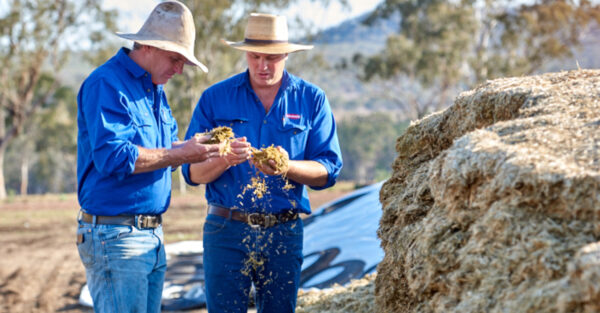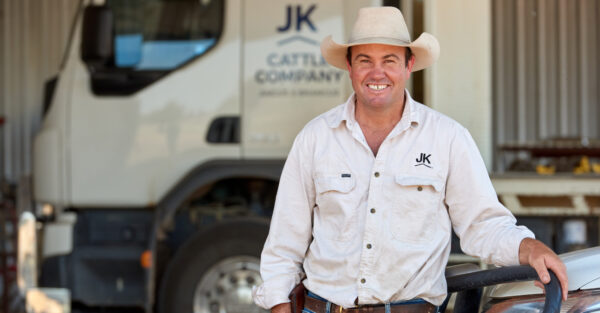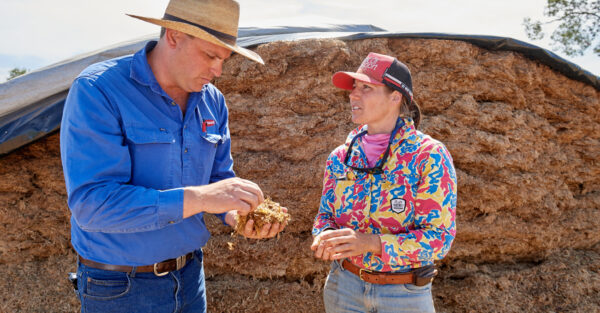Blog | Reading Time 5 minutes
Microbial solution aids in cow comfort and health in compost barn bedding
The incorporation of a unique enzyme microbial complex into dairy cow bedding material is helping with cow comfort, health and been able to minimise the incidence of environmental mastitis in a large-scale dairy barn in northern Victoria.
Aptly-named ManurePro, the complex creates a beneficial microbial population that facilitates the efficient composting of manure, urine and bedding material, reducing undesirable organisms and pathogens plus eliminating odours (ammonia) in the process.
Pat and Michelle Quinn, together with their children, Gregory, Kaleb and Erika, milk about 700 Holstein, Jersey and crossbred cows in the Mincha West district about 20 km west of Leitchville.
In the early 2000s, the family introduced a partial mixed ration feeding system as a more efficient means of utilising their precious irrigation water. Six years ago, they moved to a total mixed ration system with the construction of a 180 metre long concrete feed pad and then a massive 160 x 48 metre open-sided barn.
The intensive feeding system has significantly increased milk production and feed conversion efficiency, with average annual production being about 9,500 litres and 750 kg milk solids per cow.
Powering this is a significant cropping program that includes 900 ha of wheat and barley, 600 ha of vetch and 80 ha of maize, most of it irrigated and harvested for pit silage, hay, grain and straw.
“Our feeding program is now completely reliant on home grown forages and having high quality silage and that’s how we came to be working with Lallemand Animal Nutrition,” Kaleb Quinn says.
“About three years ago, we were having issues with the quality of our silage so we contacted one of their technical services manager’s, David Lewis, for advice.
“David has been a major help in improving our silage harvest timing and processing along with improved storage and sealing systems. Focusing on producing quality silage and training our staff about face management and reducing waste during all steps from the field to feeding out.”
The Quinns have since adopted Magniva Platinum silage inoculant, heavy duty Silostop Max oxygen barrier film, SilageKeeper UV covers and SealKeeper gravel bags into their silage program. This has provided a more secure sealing and storage of the silage and the ability to store silage longer for future droughts. It has also reduced the need for as many car tyres and reduced plastic waste on farm.
The Quinn’s are now in the process of moving from their old earth bunkers that are worn out to larger bun stacks on a new site as their operation grows.
The cows spend the entire lactation in the comfort of the barn, are fully fed with fresh mixed feed during the day, and rest on compost bedding and straw that gradually breaks down into compost.
A tractor and scarifier is used daily to turn the bedding over and maintain the bedding for the cows, another layer of straw is added as required and scarified in.
The heat generated by the composting process keeps the surface dry and controls harmful pathogens while the composting process is happening.
To be effective, the bedding system requires a population of beneficial microbes; a continual supply of nutrients, including manure, urine and straw; and a regular source of oxygen, carbon and nitrogen.
Conversely, wet or foul-smelling bedding is a tell-tale indicator of inadequate composting.
“A bad smell tells you something’s wrong but the real issue is the potential impact on cow health,” Kaleb Quinn says.
“A single case of mastitis can cost you hundreds of dollars.
“We were having problems with our cell count in 2021 and the bedding wasn’t performing too well coming into winter, that’s when David suggested we try ManurePro.
“That was a dry year and it knocked the smell out within a week and got the compost heating again in winter while the weather was wet and cold.
“It did an even better job last year when we had a really long wet winter and we had a lot of problems with wet bedding.”
ManurePro contains a specific-selected mix of enzymes, live lactic acid bacteria and Bacillus spp. strains.
The cellulolytic enzymes release fermentable sugars from lignocellulosic materials, such as straw, woodchips and manure.
Bacteria transform these sugars into lactic acid, creating an unfavourable environment for undesirable microorganisms that are potentially harmful to livestock or are associated with the production of ammonia, sulphur dihydrogen and other odours.
Improving the composting process also helps to improve nitrogen retention in the resultant compost that can add increased value to crop growing operation.
“ManurePro breaks down the straw and waste and turns it into a nice, rich, dark and sweet-smelling compost,” Kaleb says.
“This is easily the best compost we’ve made and it’s great for the paddocks.”
Composted bedding is removed at the end of summer for spreading on crop growing paddocks and the whole process starts again.
“It sounds expensive because a one kilogram pack costs about $150, but that’s enough to treat 1000 square metres, or half of our shed.
ManurePro is applied at 1g/m2 to the bedding each fortnight.
“If we use two bags a fortnight for six months of the year, it’s still cheaper than the cost and effort of treating cows for mastitis or discarding milk.”
“I’ve experimented with pushing the ManurePro application interval out to three or four weeks but we’ve noticed the cell count starts to climb and the ammonia smell comes back,” Kaleb says.
If you would like find out more about Manure Pro, speak to your local technical services manager.
Published Mar 29, 2023 | Updated Dec 4, 2023
Related articles
Need specific information?
Talk to an expert


